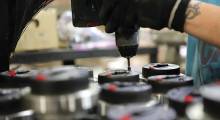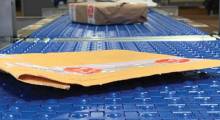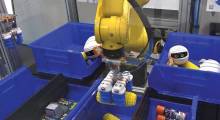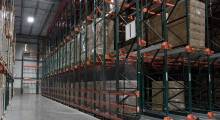Mazak Corp., Florence, Kentucky
Products: Aftermarket parts for precision machine tools
Square footage: 500,000 manufacturing space, with 45,000 sq ft devoted to spare parts fulfillment
SKUs: 46,500
Throughput: 1,000 orders per day
Employees: 8 employees run the order fulfillment area
Shifts: Staggered shifts from 7 AM – 9 PM, 6 days per week.
In the 24/7 world of manufacturing, there is no margin for error. To succeed, equipment makers must not only produce world-class machines, they must also be able to deliver world-class service when it comes to their aftermarket parts business.
“If one of our machines goes down, it’s a crisis for our customer until that machine is back in service,” says Steve Trammel, North American Parts Center manager for Mazak Corporation, a global manufacturer of advanced machine tools. “We’re shipping 1,000 aftermarket parts orders a day, and 97% of them go out that same day.”
To meet that challenge, Mazak Corporation automated the 45,000 sq ft area designated for parts distribution at its Florence, Ky manufacturing plant. The refurbished area features a state-of-the-art parts storage and retrieval system with 13 vertical lift modules (VLM) (Remstar, 800-639-5805, http://www.remstar.com/), including a wide unit capable of handling oversized parts. The area also includes pallet storage for heavy parts serviced by an automatic stacker crane. With the addition of pick-to-light technology, the order fulfillment system can handle as many as 2,000 orders in a five-hour shift – double Mazak’s current requirement, giving the machine maker room to grow.
“We wanted a system that was capable of rapidly filling orders and managing 46,000 different part numbers ranging in size from small to large and light to heavy,” says Trammel.
The benefits: In addition providing the capacity to expand within the existing footprint, Mazak reduced its labor requirements by 44% and increased productivity by 80%.
Expanding in North America
Mazak may not be a household name outside the machine tool industry, but it is the largest metal cutting builder in the world with eight manufacturing facilities in Japan, the US, the UK, Singapore and China as well as 30 technology centers world wide.
The 500,000 sq ft facility in Kentucky produces over 30 different models, at a production rate of 130 machines a month. The aftermarket parts center maintains an inventory of more than $65 million, stocking parts for every Mazak CNC sold in the Western Hemisphere.
“Mazak has made a very strong investment into its aftermarket services because we recognize that our equipment is running in many manufacturing facilities on a 24 hour/7 day a week basis,” says Trammel. “Customers are using lean manufacturing and multi-tasking machines to lower costs by reducing manpower, set ups and multiple operations. In this environment, it is extremely important that parts be immediately available.”
The Need for Automation
Before the recent upgrade, Mazak’s stockroom consisted of pallet racks and 12 VLMs that were much smaller than the new units. What’s more, the system was completely manual: At the VLM, an operator would look up a part location in a location guide next to each of the units to figure out what tray number they wanted and then manually type in that number to get the tray delivered. When the tray arrived, the operator would have to sort through 50 or 60 parts to find the specific part specified on an order sheet. The workers then carried the picked orders to the packing areas where they were packed and shipped.
But it wasn’t just manual handling that created challenges. “Nobody orders parts at 8:00 in the morning,” Trammel says. “Part orders usually come in the afternoon but we still have to get them out the same day for delivery to our customers. To push through up to 1,200 orders in a 6-hour window, we were increasingly throwing more and more manpower at the situation.”
Automating the aftermarket parts area emerged as a solution that would allow Mazak to manage more parts and same-day orders without continually adding more labor.
Adding automation
The transformation of the parts center took a little less than six months. During that period some 19,000 new part numbers were added.
The new solution involved 13 new VLMs grouped in four pods in pick-and-pass workstations. Each tray can hold up to 1,100 pounds of parts. The trays themselves are eight feet wide and 34 inches deep. One of the VLMs is a larger heavy-duty unit, which is designed for much bigger and heavier parts. Together, they create a 125-foot long picking area, with a conveyor line running in front of them.
The VLMs are also equipped with pick-to-light technology. A light bar runs across the front of the unit and directs the operator to the exact location of the part to pick and displays the quantity to pick as well as the part number.
Same Space with More Parts
The dense storage provided by the VLMs allowed Mazak to keep the same footprint in the parts warehouse while increasing storage capacity within that space by 95 percent. For instance, the old VLMs handled 20,000 individual part numbers. All of those, plus another 19,000 part numbers, are now being handled by the new VLMs, which has allowed Mazak to accommodate parts for new machine models without a problem. Another 7,000 oversized part numbers are stored on racking in the warehouse.
To ensure the accuracy of orders, Mazak created a five-point check system managed by the warehouse management system: (1) the warehouse ensures that it carries sufficient inventory so that the part will be in stock when the order arrives from a customer; (2) every part is labeled with a barcode for identification; (3) the light strip on each tray displays the stock number and part name of items to be picked for a client order; (4) when the worker puts the item in the tote, the tote itself re-displays a visual, digital message of the pick order; and (5) in the pack area the items to be shipped are checked against the original order for accuracy before it is shipped. This five point check system has improved picking accuracy from 98 percent to 99.67 percent.
The system not only increased the density of storage, operators were significantly more productive. “Previously, we were using nine workers to handle 111 orders per worker, per day,” says Trammel. “Between running to pick the part, and then taking it over to packing, it was all we could do to get our orders out.”
This new system is run with five workers, each handling 200 orders per day. Orders picked per person per hour has increased by 80 percent – 13.9 picks per labor hour before, and 25 picks per labor hour now. In addition, same day shipments improved from 95% to 97.5%. “Same-day shipping is no longer an issue,” says Trammel. “And in a 24/7 world, that has been a big improvement.”
System suppliers
Systems integrator, vertical lift module, and pick-to-light pick system: Kardex Remstar
Conveyor: Intelligrated, 513-701-7300
Warehouse management system: Dove Tree Canyon Software, 619-236-8895
Stacker crane: Automated Fork Truck (ATF), 801-676-8070
Barcode scanning: Datalogic (PSC), 800-929-3221
Barcode printers: Zebra Technologies, 847-634- 6700
This article appeared in the February 2009 issue of Modern.








